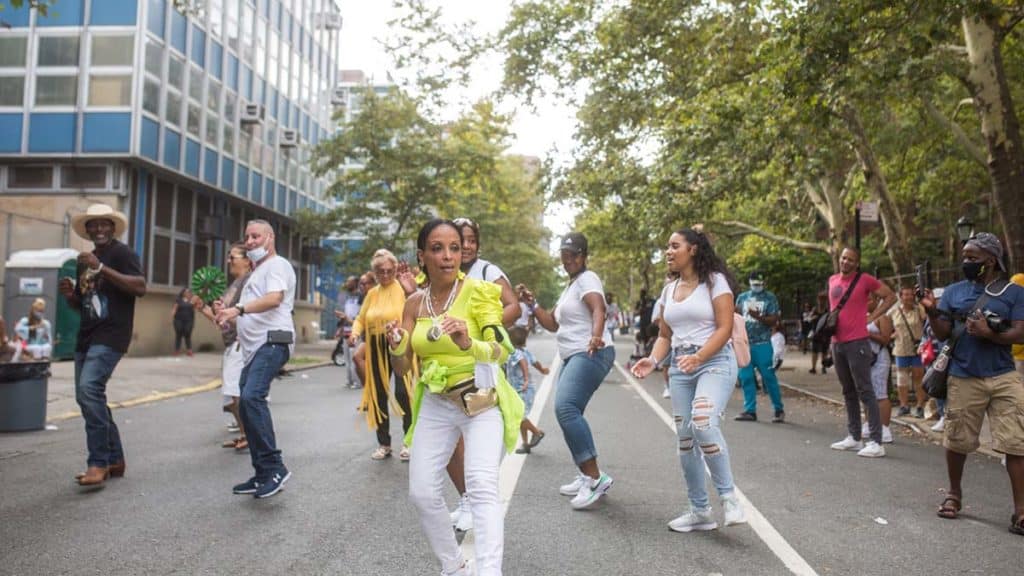The AfriBembé Festival: Sankofa!2022 is an outdoor festival of Pan-African culture produced by NYC’s Caribbean Cultural Center African Diaspora Institute (CCCADI).
4th AfriBembé Festival: Sankofa!
The CCCADI’s 4th AfriBembé Festival: Sankofa! is at Harlem Art Park and on East 120th St in “El Barrio” East Harlem on Saturday, August 13, 2022 from 11:30am – 7pm. Free. afribembe.com 🌍🇧🇷🇨🇴🇨🇺🇩🇴🇪🇨🇬🇳🇭🇹🇵🇷
The first 200 “registered guests” to arrive will get some cool CCCADI Swag when they arrive, so register at afribembe.com
This year AfriBembé celebrates Brazilian, Colombian, Cuban, Dominican, Ecuadorian, Haitian and Puerto Rican culture plus Guinean culture from Mother Africa with:
- Bembé Stage with live music and DJs.
- Family Village with creative activities for all ages including double dutch sessions with Double Dutch Dreamz and percussion workshops with OMG Cornelio.
- SoulFull Food Plaza with comfort food from the Diaspora.
- Ujamaa Marketplace with artisanal arts and crafts. “Ujamma” is a Swahili word that means the village or the extended family works together for mutual benefit.
- Sankofa Tribute honoring the late Hiram Maristany (1945-2022) who is remembered for showing the beauty of “El Barrio” in his photography. Yes the barrio can be tough, but it is beautiful if you open your eyes. Maristany opened many eyes. He was the official photographer of the Young Lords and Director of El Museo del Barrio from 1974-77. Obituary nytimes.com
Bembé Stage Performers
Caridad de la Luz “La Bruja” hosts: @labrujanyc 🇵🇷
- Eddie Montalvo y Su Orquesta (Fania All-Star)
- Sidiki Conde & Tokounou Dance Company sidikiconde.com 🇬🇳
- Batalá New York @batalanewyork 🇧🇷
- Bomba Yo @bombayony 🇵🇷
- Legacy Women @legacywomennyc (Women’s Afro-Caribbean Drums) 🇩🇴🇵🇷
- Rasin Okan 🇭🇹
- Madame Vacile @madamevacile 🇨🇴
- DJ Mickey Perez @djmickeyperez 🇨🇺🇪🇨
That’s a great lineup. Do go early because the first 100 arrivals will receive a free raffle ticket for something cool from CCCADI.
Bembé
Bembé can be a religious celebration or just a party. In West African and Central African tradition, a Bembé is a community dance for the orishas. Dancing with the community is how we pray, so even if you are just dancing for fun, it is still uplifting.
In the time before phones, internet, television, radio and even books, bembé was all there was to do. Communities would gather regularly to sing, drum and dance together. Elders would sing the old stories. People would buy and sell things. There would be a lot of eating and drinking and lots of socializing (LOL).
Congo Square in French New Orleans was the beginning of African Diaspora culture in what became the United States. It was a bembé in every sense of the word.
A bembé was actually more than a party. It was a history lesson and a cultural education. It was community school. Traditional communities did basically the same thing all over the world. Many still do.
Interestingly, Indigenous traditions of the Americas and Taíno traditions of the Caribbean are very similar to the traditions of Mother Africa. A Taíno areíto was a community celebration that would go on for three or more days, just like in Mother Africa. A Native American Pow-Wow is the same thing. This is a very human tradition.
A traditional Latin party is still like that. We start Friday night when work ends, finish Monday morning and then go right back to work. The CCCADI AfriBembé Festival carries on our traditions.
Sankofa
One of the cool things about the CCCADI is how they place old traditions in a contemporary New York City context.
“Sankofa” is a Ghanian term that means “to retrieve.” An associated proverb says, “It is not wrong to go back for that which you have forgotten.” 🇬🇭
The broader meaning is that to create the best future, learn from the past. That’s an old idea that is the essence of modernity. To make a decision, evaluate all the available information. When information changes, you may have to change your decision. In the postmodern internet era, the available information has expanded exponentially, so we are putting that to good use now.
Ghanaians have a rich tradition of using pictograms in art. Ghanian architecture and textiles tell stories.
The symbol of Sankofa is a bird looking over its shoulder to pick an egg off its back. What does the egg represent? It represents fertility, creativity and the possibilities of the future. The AfriBembé logo is a stylized Sankofa bird. The image above is from the Brooklyn Museum’s wonderful African collection. brooklynmuseum.org
Sankofa can also be represented by a stylized heart. We don’t know if it’s related, but notice the symbol in the Fon traditions of old Dahomey (Benin), Haiti and New Orleans. When the African Burial Ground was explored in NYC’s Financial District in 1991, one of the coffins had the stylized heart on its lid. It’s now the symbol of the African Burial Ground National Monument.
We tend to associate the heart with the female aspect. That aligns with the fact that women are the guardians of culture. Who keeps the knowledge of the old ways and medicine in the plants, and who runs the CCCADI: women.
Sankofa is especially important in African Diaspora and Indigenous communities because colonizers tried to strip away our identity and our past. It’s surprising how much of our culture survived 500 years in secret at home. Some has been reclaimed and some is being recreated now. We have so much to be proud of. It’s all good. It’s Sankofa!
Harlem Art Park
Harlem Art Park is on 120th St, between Lexington and Third Avenue. The party extends out of the park onto 120th St.
For our ancestors and our children: Ashé

